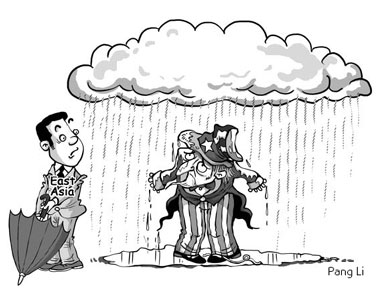Dealing with a future of economic uncertainty
By James W. Adams (China Daily)
Updated: 2008-04-02 07:23
Updated: 2008-04-02 07:23
A decade ago, the world watched and wondered as East Asia endured the full force of a financial crisis, with currencies and asset prices across the region falling sharply, and millions of people cast back into absolute poverty.
It is a measure of how far East Asia has come in just 10 years that today, with a credit and housing crisis now sweeping the United States, and the US dollar dropping to new lows against other currencies, East Asia is watching and wondering about the impact.
There will be an impact, of course, just as the developed economies were affected by the Asian financial crisis of 1997-98. In a globalized economy, there is no hiding place. But unless the situation in the world's biggest economy deteriorates suddenly or the downturn there is much deeper and longer than anticipated, developing East Asia should emerge with lower - we estimate 1-2 percentage points lower than 2007 - but still strong growth rates.
Coming off the highest year of growth since the crisis - developing East Asia recorded 10.2 percent last year - the region is in a good position. Reserves are high (over $2.5 trillion for developing East Asia), economies are being prudently managed, most governments have space to cut taxes or fund labor-intensive projects if they have to, banks have fewer non-performing loans, and debt burdens are much lower.

These are not the same economies that trembled and almost cracked 10 years ago as capital drained out of the region. Led by the extraordinary performance of China, the countries of East Asia are much stronger and better positioned in almost every respect.
There is, of course, a "but", and it is that this is not a normal economic downturn - indeed, far from it. East Asia faces hazards on three fronts, all of which have to be managed simultaneously.
First is the impact of the US slowdown, which will cut growth rates in Asia as exports to the US slow. There is also the risk that investors in Asia will pull back a little to wait and see how the US situation plays out, dampening credit and equity markets slightly. Already we have seen indications of both these side-effects. More may follow.
Second, is the impact of high fuel and food prices. Oil, grains and metals are all commanding record prices, mainly driven by demand increases, not supply shortages. These prices are pushing up costs for ordinary consumers and also forcing governments to deal with the implications of renewed inflationary pressure and, in some cases, the increased budgetary impact of such things as fuel subsidies.
Though some higher food prices are good for farmers, overall these higher prices have a harsh impact on the poorest people of Asia. Mindful of the need to maintain social stability, governments will be keeping a close eye on any signs that the poor and marginalized are being hurt, and some are already acting to cushion impacts on the poor.
At such times it is important to ensure that the poor are not hurt disproportionately - for basic humanitarian as well as social and economic reasons - but it is equally important that support be provided to them in ways that do not lock in new market distortions that will have their own, negative impacts later on.
Any economic interventions to reduce the impact of higher fuel and food prices should be targeted, temporary, and part of a coordinated policy approach that allows local markets to respond and adapt to changes, including in prices - some of which, at least, seem set to be high for a while to come.
Third, and directly linked to the first two, are the continuing policy challenges of moving from middle-income to higher income levels. A slowdown in growth accentuates the competitive and structural challenges facing governments and societies, even as responding to them become more difficult. Of course, these challenges differ from country to country: labor policies in one, subsidies in another, public administration in another.
East Asian leaders will find themselves dealing with higher prices at a time of slower growth, while their own pressing policy issues nag for solution - solutions which may impact either growth or prices. And, bear in mind also that this is happening as the South East Asian region presses on toward the 2015 goal of economic integration.
In their first meeting since the historic ASEAN summit last December, finance ministers from the 10 member economies are gathering this week in Vietnam. They confront an immediate future of great uncertainty. A good 2007 should not breed complacency in 2008.
The author is vice-president of East Asia & Pacific Region, the World Bank
(China Daily 04/02/2008 page9)
|
|
|
|